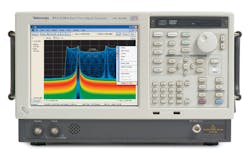Real-time spectrum analyzers (RSAs) are designed to let no signal pass—they provide the measurement capabilities to capture the most dynamic signals, even those with advanced digital modulation. And for those with test needs through 26.5 GHz, one of the best known lines of RSAs—the RSA5000 Series from Tektronix—has recently been expanded with analyzers for use from 1 Hz to 15.0 GHz and 1 Hz to 26.5 GHz. Known respectively as models RSA5115A and RSA5126A, these analyzers can be specified with acquisition bandwidths as wide as 110 MHz to capture the most elusive, complex modulated signals.
Both new models (see figure) feature a computer-like control panel and full-color display screen. They are available with a wide range of options and capabilities, including acquisition bandwidths of 25, 40, 85, and 110 MHz; versatile triggering functions; and preamplifiers. With Tektronix’s heritage in different instrument areas, it is possible to see how these RSAs combine the functions of a high-performance spectrum analyzer, a wideband vector signal analyzer, and the advanced triggering capabilities of a high-speed digital storage oscilloscope.
Both new analyzers can trigger on power, runt signals, signal density, frequency, and—as an option—specific frequency masks (to monitor changes in frequency within the acquisition bandwidth). For example, the RSAs can trigger on a range of power settings of 0 to -100 dB from the reference level, with the reference level adjustable across a range of -170 to +50 dBm in 0.1-dB steps.
The instruments show results on the firm’s DPX® spectrum display with live color view of signals changing over time in the frequency domain, for a quick check on signal stability. The DPX display can also be used as part of a DPX Density™ trigger, which works on the measured frequency of occurrence of an event or the density of the DPX display. A Trigger On This™ function allows an operator to point an on-screen cursor at a signal of interest on the DPX display and automatically set a trigger level to capture signals below the measured density level.
Both analyzers provide the capability to capture very low-level signals in the presence of much higher-level signals. Minimum event capture durations are 30.7 μs for a 25-MHz acquisition bandwidth, 11.4 μs for a 40-MHz acquisition bandwidth, and 3.7 μs for an 85- or 110-MHz acquisition bandwidth. Trigger position timing uncertainties are minimal for the Frequency Mask Trigger: only ±20 ns for a 25-MHz acquisition bandwidth, ±15 ns for a 40-MHz acquisition bandwidth, and ±12 ns for an 85- or 110-MHz acquisition bandwidth. Center frequencies for both analyzers can be set with 0.1-Hz resolution.
In addition to their broad frequency ranges, both RSAs feature wide amplitude measurement ranges. They exhibit a displayed average noise level (DANL) of -155 dBm/Hz at 2 GHz and -142 dBm/Hz at 26.5 GHz, coupled with a high third-order-intercept (TOI) point of +17 dBm at 2 GHz for both analyzers. The instruments include options for an internal preamplifier capable of providing a DANL of -167 dBm/Hz at 1 GHz and -156 dBm/Hz at 26.5 GHz. The instruments offer excellent amplitude characteristics, with frequency responses of ±1.0 dB from 1 Hz to 15 GHz and ±1.2 dB from 1 Hz to 26.5 GHz, when measured with 10-dB attenuation and no preamplifier. The absolute amplitude accuracy at a measurement center frequency, with 95% confidence, is ±1.5 dB from 1 Hz to 15 GHz and ±1.8 dB from 1 Hz to 26.5 GHz.
Both RSAs operate from an internal 10-MHz frequency reference oscillator and can also work with an external 10-MHz reference source. Both instruments can perform high-speed sweeps, such as across 1 GHz, with a 10-kHz resolution bandwidth filter in less than 1 s. They offer resolution-bandwidth (RBW) filters from 0.1 Hz to 5 MHz, with an option for 10 MHz, and video-bandwidth filters from 1 Hz to 5 MHz. Input attenuation can be set from 0 to 55 dB, in 5-dB steps. The standard acquisition memory size for each RSA is 1 GB, with an option for 4 GB. The analyzers are based on sampling input signals with a 100-MSamples/s, 14-b analog-to-digital converter (ADC), although some options incorporate a 300-MSamples/s, 14-b ADC.
The RSAs, which are ideal for communications and radar signal analysis and even electronic-warfare (EW) signal analysis, can acquire more than 7 s signal time with a 110-MHz acquisition bandwidth. They include a built-in DVD drive for data storage. The instruments are available with a wide range of options and can perform any number of programmable measurements. These include automated phase-noise and settling-time (frequency and phase) measurements; electromagnetic-interference (EMI) diagnostics; and advanced signal analysis (including pulse measurement) when properly equipped. For example, automatic orthogonal-frequency-division-multiplex (OFDM) analysis of IEEE 802.11a/g/j and WIMAX 802.16-2004 wireless standards is available as an option. P&A: $47,900 and up (USD, 26.5-GHz model).
Tektronix, Inc., 14150 SW Karl Braun Dr., P.O. Box 500, Beaverton, OR 97077; www.tek.com.
About the Author
Jack Browne
Technical Contributor
Jack Browne, Technical Contributor, has worked in technical publishing for over 30 years. He managed the content and production of three technical journals while at the American Institute of Physics, including Medical Physics and the Journal of Vacuum Science & Technology. He has been a Publisher and Editor for Penton Media, started the firm’s Wireless Symposium & Exhibition trade show in 1993, and currently serves as Technical Contributor for that company's Microwaves & RF magazine. Browne, who holds a BS in Mathematics from City College of New York and BA degrees in English and Philosophy from Fordham University, is a member of the IEEE.
